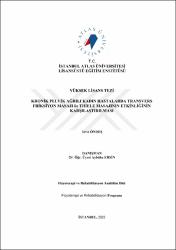Kronik pelvik ağrılı kadın hastalarda transvers friksiyon masajı ile thiele masajının etkinliğinin karşılaştırılması = Comparison of the effectiveness of transverse friction massage and thiele massage in female patients with chronic pelvic pain
Citation
Öndeş, S. (2023). Kronik pelvik ağrılı kadın hastalarda transvers friksiyon masajı ile thiele masajının etkinliğinin karşılaştırılması.(Yüksek lisans tezi, İstanbul Atlas Üniversitesi, İstanbul). Erişim adresi https://hdl.handle.net/20.500.12900/146Abstract
Kronik pelvik ağrı (KPA), pelvik bölgede altı aydan fazla süren; hamilelik, menstrüal siklus, lokal travma veya pelvik cerrahilere bağlı olmayan ağrı olarak tanımlanır. Prevalansı yadsınamayacak şekilde yüksek olan KPA genellikle muskuloskeletal sorunlardan kaynaklanır. Tedavide fizyoterapi girişimleri son derece önemlidir. Bu çalışmanın amacı, KPA'lı kadın hastalarda pelvik taban kaslarına uygulanan transvers friksiyon masajı (TFM) ile Thiele masajının (TM) etkinliğin karşılaştırılmasıdır. 20 hasta TFM grubu ve TM grubu olmak üzere 10'ar kişilik iki gruba ayrılmıştır. TFM grubuna 4 hafta boyunca haftada 2 gün TFM, TM grubuna ise aynı süre ve sıklıkla TM uygulanmıştır. Pelvik taban kaslarında hassasiyet, skar doku, tetik nokta ve spazm varlığı fizyoterapist tarafından dijital palpasyon ile, ağrı Vizüel Analog Skala ve McGill Melzack Ağrı Anketi ile, yaşam kalitesi Nottingham Sağlık Profili ile, cinsel fonksiyonlar Kadın Cinsel İşlev Ölçeği ile, alt üriner sistem semptomları ise Bristol Kadın Alt Üriner Sistem Semptomları İndeksi ile değerlendirilmiştir. Değerlendirmeler tedaviden önce ve sonra olmak üzere 2 kez uygulanmıştır. Çalışmanın sonunda tedavi öncesine göre TFM grubunda ağrı, yaşam kalitesi, cinsel fonksiyonlar ve alt üriner sistem semptomları skorlarında istatistiksel olarak anlamlı iyileşmeler görülmüştür (p<0,05). TM grubunda da ağrı, yaşam kalitesi ve alt üriner sistem semptomları skorlarında istatistiksel olarak anlamlı gelişmeler görülürken (p<0,05) cinsel fonksiyonlarda anlamlı bir iyileşme saptanmamıştır (p>0,05). İki grubun birbiriyle karşılaştırılmasında ise gruplar hiçbir parametrede istatistiksel olarak anlamlı bir fark bulunamamıştır (p>0,05). Sonuç olarak KPA hastalarında pelvik taban kaslarına uygulanan TFM ve TM, hastalığın semptomlarını azaltabilecek ve hastaların yaşam kalitesini artırabilecek kolay uygulanabilir noninvaziv tedavi yöntemleridir. Chronic pelvic pain (CPP) is defined as pain lasting more than six months in the pelvic region which is not related to pregnancy, menstrual cycle, local trauma or pelvic surgery. CPP, whose prevalence is undeniably high, is usually caused by musculoskeletal problems. Physiotherapy interventions are extremely important in treatment. This study conducted to investigate to compare the effects of transverse friction massage (TFM) and thiele massage (TM) in female patients with CPP. Study planned as a pilot study and 20 patients participated. Patients divided into two groups as TFM group and TM group (nTFM=10 ; nTM=10). TFM was applied to the TFM group 2 days a week for 4 weeks, and TM was applied to the TM group for the same duration and frequency. Presence of tenderness, scar tissue, trigger points and spasm in the pelvic floor muscles evaluated by digital palpation, pain levels evaluated by Visual Analog Scale and McGill Melzack Pain Questionnaire, quality of life evaluated by Notthingam Health Profile Questionnaire, sexual functions evaluated by Female Sexual Function Index and lower urinary tract symptoms evaluated with the Bristol Female Lower Urinary System Symptom Index. Evaluations were applied before and after the treatment. At the end of the study, statistically significant improvements were observed in pain, quality of life, sexual functions and lower urinary system symptoms scores in the TFM group compared to pre-treatment (p<0.05), while statistically significant improvements were observed in pain, quality of life and lower urinary system symptoms scores in the TM group (p<0.05) yet there was no significant improvement in sexual functions (p>0.05). When the two groups were compared with each other, no statistically significant difference was found in any of the parameters between the groups (p>0.05). As a result, TFM and TM applied to the pelvic floor muscles in CPP patients are easily applicable noninvasive treatment methods that can reduce the symptoms of the disease and increase the quality of life of the patients.

















